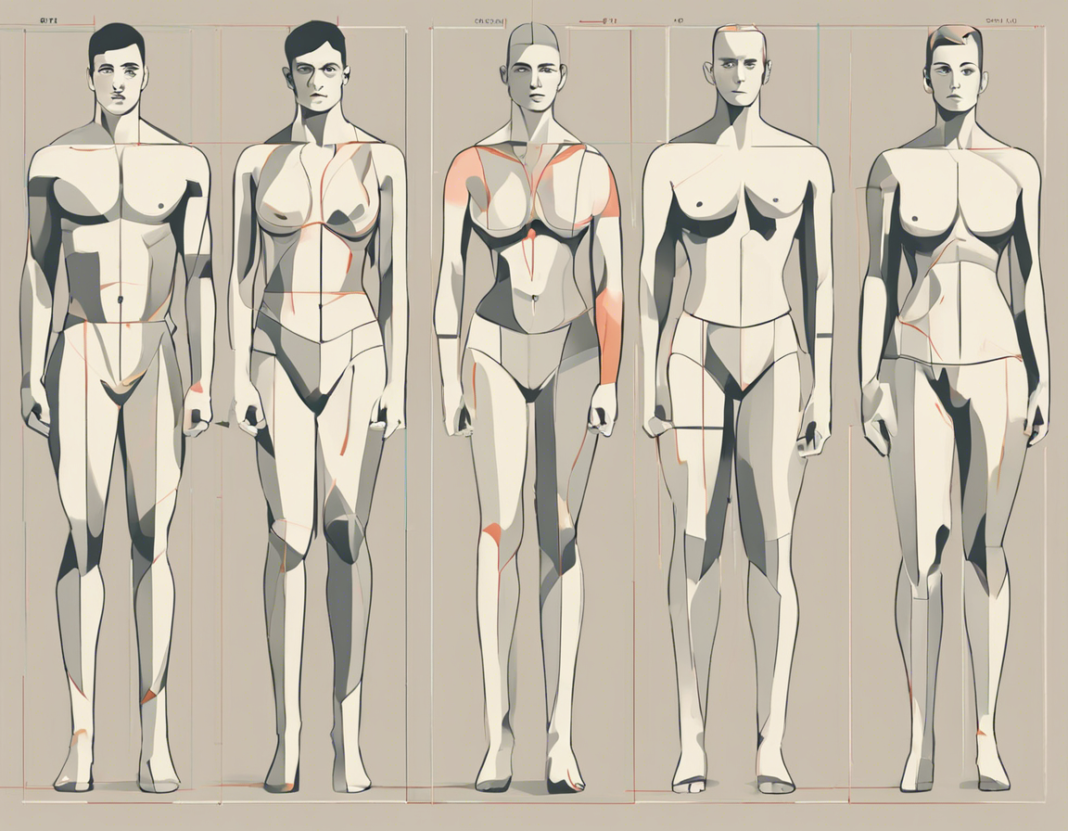The Bottom Line:
- Understanding body fat percentage and its importance
- Healthy levels of body fat based on age and gender
- Importance of maintaining a healthy body fat percentage for overall well-being
- Variations in ideal body fat percentages based on goals and gender
- Tips for lowering body fat percentage through nutrition, portion control, hydration, exercise, and lifestyle habits
Understanding Body Fat Percentage
Body fat percentage refers to the proportion of your body weight that comes from fat tissue. While some amount of fat is essential for the body, too much excess fat can lead to various health issues and diseases. Understanding healthy levels of body fat is crucial for overall well-being.
The Importance of Healthy Body Fat Percentage
Maintaining a healthy body fat percentage is linked to a reduced risk of chronic diseases such as diabetes, heart disease, and certain forms of cancer. It also plays a significant role in hormonal balance and energy levels, highlighting its importance for overall health.
Optimal Body Fat Percentage for Different Individuals
The ideal body fat percentage varies based on individual goals. Generally, men should aim for around 10 to 20 percent body fat, while women should target 18 to 28 percent for optimal health. Athletes may have lower percentages, but extreme levels, like those seen in professional bodybuilders at around five percent during competitions, are not sustainable in the long term.
Endurance athletes, like marathon runners, may carry less body fat compared to strength athletes, emphasizing the role of body fat in performance optimization. One’s metabolism and hormonal balance can also change with age, influencing body fat levels.
Factors Affecting Body Fat Percentage
Body fat percentage is influenced by factors such as nutrition, exercise, metabolism, and age. Nutrition plays a key role in managing body fat, with a balanced diet and portion control being essential components of fat loss efforts.
Measuring body fat can be done through various methods, such as calipers, bioelectrical impedance scales, and DEXA scans. While these methods have their pros and cons, tracking progress and changes over time can be more important than focusing solely on a specific number.
To lower body fat percentage effectively, individuals are advised to focus on balanced nutrition, moderate calorie deficits, portion control, adequate hydration, strength training, cardiovascular workouts, prioritizing protein intake, quality sleep, stress management, consistency, and patience. These holistic approaches support sustainable fat loss and overall well-being.
Remember, achieving a certain body fat percentage should not compromise your health or happiness. Embrace a balanced approach that prioritizes long-term well-being over short-term aesthetic goals.
Healthy Levels of Body Fat in Men and Women
Healthy Levels of Body Fat in Men and Women
According to the American Journal of Clinical Nutrition, healthy body fat percentage varies based on age. For individuals aged 20 to 39, women should aim for approximately 21 to 32 percent body fat, while men should target 8 to 19 percent. In the 40 to 59 age group, women should fall within 23 to 33 percent, and men around 11 to 21 percent.
The Significance of Body Fat Percentage
Maintaining a healthy body fat percentage is essential for overall well-being as it is associated with a reduced risk of chronic diseases like diabetes, heart disease, and certain forms of cancer. Additionally, it plays a crucial role in hormonal balance and energy levels.
While body fat percentage is important for everyone, individuals with specific fitness goals, athletes, or bodybuilders may pay closer attention to their body fat levels. It’s vital to emphasize that the focus should be on optimizing performance and health rather than solely aesthetics.
Ideal body fat percentages vary depending on individual goals and gender. For men, a healthy range is typically around 10 to 20 percent, while women should aim for 18 to 28 percent. Athletes may target lower percentages, but extreme levels, such as those seen in professional bodybuilders at around five percent during competitions, are not sustainable in the long term.
Endurance athletes, like marathon runners, may have lower body fat levels compared to strength athletes, highlighting the role of body fat in optimizing performance. Metabolism and hormonal balance can also shift with age, influencing changes in body fat composition.
Various methods, such as calipers, bioelectrical impedance scales, and DEXA scans, can be used to measure body fat. It’s important to note that rather than fixating on a specific number, tracking progress and changes over time is key to monitoring body fat changes effectively.
To effectively reduce body fat percentage, individuals are advised to focus on balanced nutrition, moderate calorie deficits, portion control, hydration, strength training, cardiovascular workouts, adequate protein intake, quality sleep, stress management, consistency, and patience. These holistic approaches support sustainable fat loss and overall well-being.
Importance of Maintaining a Healthy Body Fat Percentage
Impact of Maintaining a Healthy Body Fat Percentage
Maintaining a healthy body fat percentage is crucial for overall well-being as it is associated with a reduced risk of chronic diseases like diabetes, heart disease, and certain forms of cancer. Additionally, it plays a significant role in hormonal balance and energy levels, highlighting its importance for overall health.
Significance in Performance Optimization
While body fat percentage is important for everyone, individuals with specific fitness goals, athletes, or bodybuilders may pay closer attention to their body fat levels. It’s vital to emphasize that the focus should be on optimizing performance and health rather than solely aesthetics.
Varying Ideal Body Fat Percentages
Ideal body fat percentages vary depending on individual goals and gender. For men, a healthy range is typically around 10 to 20 percent, while women should aim for 18 to 28 percent. Athletes may target lower percentages, but extreme levels, such as those seen in professional bodybuilders at around five percent during competitions, are not sustainable in the long term.
Endurance athletes, like marathon runners, may have lower body fat levels compared to strength athletes, highlighting the role of body fat in optimizing performance. Metabolism and hormonal balance can also shift with age, influencing changes in body fat composition.
Various methods, such as calipers, bioelectrical impedance scales, and DEXA scans, can be used to measure body fat. It’s important to note that rather than fixating on a specific number, tracking progress and changes over time is key to monitoring body fat changes effectively.
To effectively reduce body fat percentage, individuals are advised to focus on balanced nutrition, moderate calorie deficits, portion control, hydration, strength training, cardiovascular workouts, adequate protein intake, quality sleep, stress management, consistency, and patience. These holistic approaches support sustainable fat loss and overall well-being.
Optimizing Performance Through Ideal Body Fat Percentage
Enhancing Performance Through Optimal Body Fat Percentage
Optimizing performance through ideal body fat percentage is essential for individuals striving to achieve peak physical conditioning. Athletes, fitness enthusiasts, and health-conscious individuals can benefit from maintaining an optimal balance of body fat to enhance their performance levels.
Striving for Ideal Body Fat Levels
Attaining the ideal body fat percentage is a pivotal aspect of performance optimization. Men aiming for a body fat percentage between 10 to 20 percent and women targeting 18 to 28 percent can strike a balance between health, aesthetics, and performance. While athletes may aim for lower percentages, extreme levels, such as those observed in professional bodybuilders during competitions at around five percent, are not sustainable long-term.
Endurance athletes, like marathon runners, may have lower body fat levels compared to strength athletes, emphasizing the impact of body fat on performance optimization. Additionally, alterations in metabolism and hormonal equilibrium with age can influence fluctuations in body fat composition.
Measuring and Managing Body Fat Percentage
Various techniques exist for measuring body fat, including calipers, bioelectrical impedance scales, and DEXA scans. While each method has its advantages and limitations, the primary focus should be on monitoring changes over time rather than fixating on a specific number. Tracking progress allows individuals to assess the efficacy of their fat loss efforts accurately.
To effectively decrease body fat percentage, individuals should adopt a holistic approach that encompasses balanced nutrition, moderate calorie deficits, portion control, adequate hydration, strength training, cardiovascular exercises, optimal protein consumption, quality sleep, stress management, consistency, and patience. By embracing these comprehensive strategies, sustainable fat loss and overall well-being can be supported.
Strategies for Lowering Body Fat Percentage
Effective Strategies for Lowering Body Fat Percentage
Lowering body fat percentage requires a multifaceted approach that combines nutrition, exercise, and lifestyle choices. Here are some strategies to help you achieve your goals:
1. Balanced Nutrition
Focus on a well-rounded diet that includes lean proteins, healthy fats, complex carbohydrates, and plenty of fruits and vegetables. Avoid extreme diets and aim for sustainable eating patterns that support long-term health and fat loss.
2. Moderate Calorie Deficit
To lower body fat percentage, aim for a moderate calorie deficit by consuming fewer calories than you expend. Ensure you still meet your body’s nutritional needs while creating a slight energy deficit for fat loss.
3. Portion Control
Practice mindful eating by paying attention to portion sizes, hunger cues, and fullness signals. Use strategies like using your fist as a guideline for protein, carbs, fats, and vegetables to control portion sizes effectively.
4. Hydration
Stay hydrated by drinking plenty of water throughout the day. Adequate hydration can help control appetite, support metabolism, and enhance overall health.
5. Strength Training
Incorporate strength training exercises into your fitness routine to build muscle mass, boost metabolism, and promote a leaner body composition. Muscle tissue burns more calories at rest, aiding in fat loss.
6. Cardiovascular Workouts
Add cardiovascular exercises like jogging, cycling, swimming, or high-intensity interval training to your routine to burn calories, improve heart health, and accelerate fat loss. Cardio workouts help increase energy expenditure and enhance fat-burning processes.
7. Prioritize Protein Intake
Eat protein-rich foods such as lean meats, poultry, fish, beans, and dairy products to support muscle preservation, promote satiety, and aid in fat loss. Protein consumption is crucial for maintaining lean body mass during weight loss.
8. Quality Sleep
Aim for 7 to 9 hours of quality sleep each night to regulate hormonal balance, support recovery, and optimize fat loss efforts. Poor sleep can disrupt metabolism and appetite regulation, hindering weight management goals.
9. Stress Management
Practice stress-reducing techniques like meditation, deep breathing, yoga, or mindfulness to manage cortisol levels and reduce emotional eating. Chronic stress can impede fat loss progress and overall well-being.
10. Consistency and Patience
Stay consistent with your nutrition and exercise routines, and be patient with your progress. Sustainable changes over time yield lasting results, avoiding the pitfalls of crash diets or extreme measures that may compromise health and lead to rebound weight gain.
By following these holistic approaches and focusing on long-term well-being rather than short-term aesthetic goals, you can effectively lower your body fat percentage and achieve a healthier, more balanced lifestyle.





